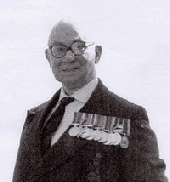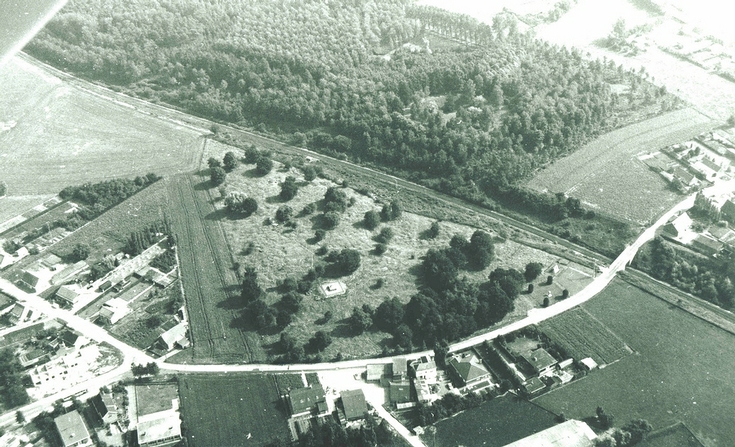



The Parish Church of St George the Martyr, Waterlooville

Diaries of a First World War Bugler
Now, to take this hill by storm was an absolute absurdity and consequently it was blown up at an enormous expense. At the time the hill was blown up our regiment, the Q.V.R.s, were in huts at Ouderdom and witnessed the bombardment well back. This was on Sunday, 17th, and the following day we were called out and marched bang into Ypres, took bombs to the firing line the same night and straight into reserve on Monday at dawn, and dug ourselves in on the side of the railway cutting. At 7 o’clock the next evening the German bombardment started and will ever remain in my memory. We, the reserve, were called up, the Bedfords had lost the left edge of Hill 60 and our regiment, the Queen Victoria’s Rifles, had to get it back. Now to reach the firing line was a long job and as we started the journey we were simply pelted with shells, shrapnel, whizz-bangs and stink bombs. It was awful. After we had succeeded in taking the Hill back again No. 1 Platoon of ‘A’ Company were told off to take an advance trench which was right in front of “Crater” which was a struggling mass of German and English bodies, wounded and dead. Sergeant T. Pullein and 26 men, all that was left of his platoon, started off. They had not gone 6 yards before Major Lees was killed; his last words were “Take it at all costs”. Another 10 yards saw the platoon reduced to a Sergeant and 10 men. The final dash was made and the trench taken, but, alas, it was left to Sergeant Pullein and 6 men to hold it.
Ammunition was running short but, remembering the Major’s words they resolved to fight to the last man. Luckily Lieutenant Wooley heard of their plight and, leaving his position in daylight, he crawled into the trench where he found a box of hand-grenades and bombs. Standing on the parapet he continued throwing these at the enemy until we were relieved at night by the Devons. The communication trench was packed with our wounded and the original fire trench had been blown to hell. What a sight!, believe me and weren’t they smacking it over too! The dead men lying around were many in number and looked awful.

To mark the 100th anniversary of the outbreak of World War I, we are continuing the serialisation of the diaries of Bugler John McCormack - Eileen Oades Uncle and Rosemary Monk’s Great Uncle.
After leaving the hill, the battalion shifted back to a safer place where they stayed for 2 nights when they were relieved by the Camerons. We then started back for billets after being highly complimented by General Smith Dorien over the Hill 60 do. Sergeants Pullein and Peabody got the D.C.M. and Lieutenant Wooley the V.C. - the first in the Territorial Army. One hour saw us out of billets again. Something very serious had happened. The Germans, Prussian Guards, had broken through; the French were the cause, - now what would have been your feelings after this? Everywhere you could see the French retreating - the devils! We were mustered on the parade ground, much to our disgust. Charge magazines! was the order and in doing this operation one of our chaps accidentally shot his pal dead, and whilst the French were retreating we simply crossed the field and dug ourselves in and waited for the Germans who were coming at all speed. We were fully prepared for the end, but, half a mo’, the Canadians were in front of us, thank God for that! A whole division of them; they soon got well into the enemy and, after a desperate fight lasting all night, the Canadians succeeded in driving the enemy back 5 miles and recapturing 6 guns, but not without heavy losses. Our own strength was very weak. We had lost heavily but, knowing these lads were in front, enabled us to have a broken sleep that night, but out we hustled again at dawn, took back in reserve for a day and in the afternoon took up another position for another attack on the Yser Canal. More trenches were taken by the Brigade, and still more heavy losses entailed this operation. We took up ammunition to the captured position, returned to the canal bank, stopped here all through the cold night, and in the afternoon of the following day started off across country under terrible fire to take part in the battle that was proceeding. We arrived at our destination after running that awful gauntlet once more and strengthened the position which was being held by the Buffs. Here we remained for two days during which we encountered terrific shelling and finally left this position on the morning of APRIL 26TH 1915, when we returned to billets in a farm just a little way back. From here we did another 24 hours in the trenches and finally left our billet, called the “Chicaries”, for a wood in the region of Poperinghe where we bivouacked.
I might mention that, following the Yser Bank battle, we had to pass through a place called St Julienne which was alight from beginning to end and being shelled as we went through. What a sight!, dead horses and men lying in the roads, bits of wagons, harness, rifles etc., all these made our journey difficult and you imagine, a whole battalion, or rather what is left of them, going through in single file. Here it was that we lost all our machine-guns and men blown all over the show. My poor old chum, Bugler King, who was attached to the gun, was seriously wounded and died later. Any man who went through Hill 60 and St Julienne had done his bit without ever doing any more. Well done the Vies! Now to give a description of the Retirement from Ypres.
MAY 11TH 1915
The Germans used gas for the first time against their opponents. Immediately in front of us on the front were the Algerian troops covered by the French artillery. Over came the gas; men dropped where they stood, the remainder were so terrified that they dropped their rifles and ran. Here, indeed, was a fine to-do. Ypres was in great danger of falling into the enemies’ hands; part of it was on fire. Old men and women left the city as fast as they could; mothers were to be seen with babies in their arms and children clinging to their skirts, all of them terrified by the din, not saying anything of the shells which were dropping amongst us. Now what was taking place from the military point of view? Troops were being rushed up, ammunition both small and large was being dashed up, guns R.F.A. and R.H.A. were being brought up in spite of the seriousness of the whole thing. I cannot help but say what a splendid thing it was to see our boys rushing up to drive back the enemy. What a marvellous sight it was to see those good old regulars bring the guns into action and horses to each gun. Meanwhile two Canadian divisions had come up and they, together with the 5th Division, pushed the Germans back.
To be continued

A photo of Hill 60 in more recent years.
It was called Hill 60 as it stands 60 metres high and was created from the spoil removed in the creation of the nearby railway cutting. Consequently it was of great strategic importance, overlooking a main route to Ypres.
APRIL 19TH 1915.
Today I want to give you an account of the battle of HILL 60, YPRES. I had previously spoken of the blowing up of mines etc., well, this operation took place in the trenches our battalion had just finished 5 days in, namely 38 and 39 trenches. Whilst here the engineers or special employed miners, for that’s what they really were, were working three shifts on this job and the fullest of information I got from them. Immediately in front of 39 trench was Hill 60 and leading from the same was a communication trench directing to Hill 60, now being held by the enemy.






